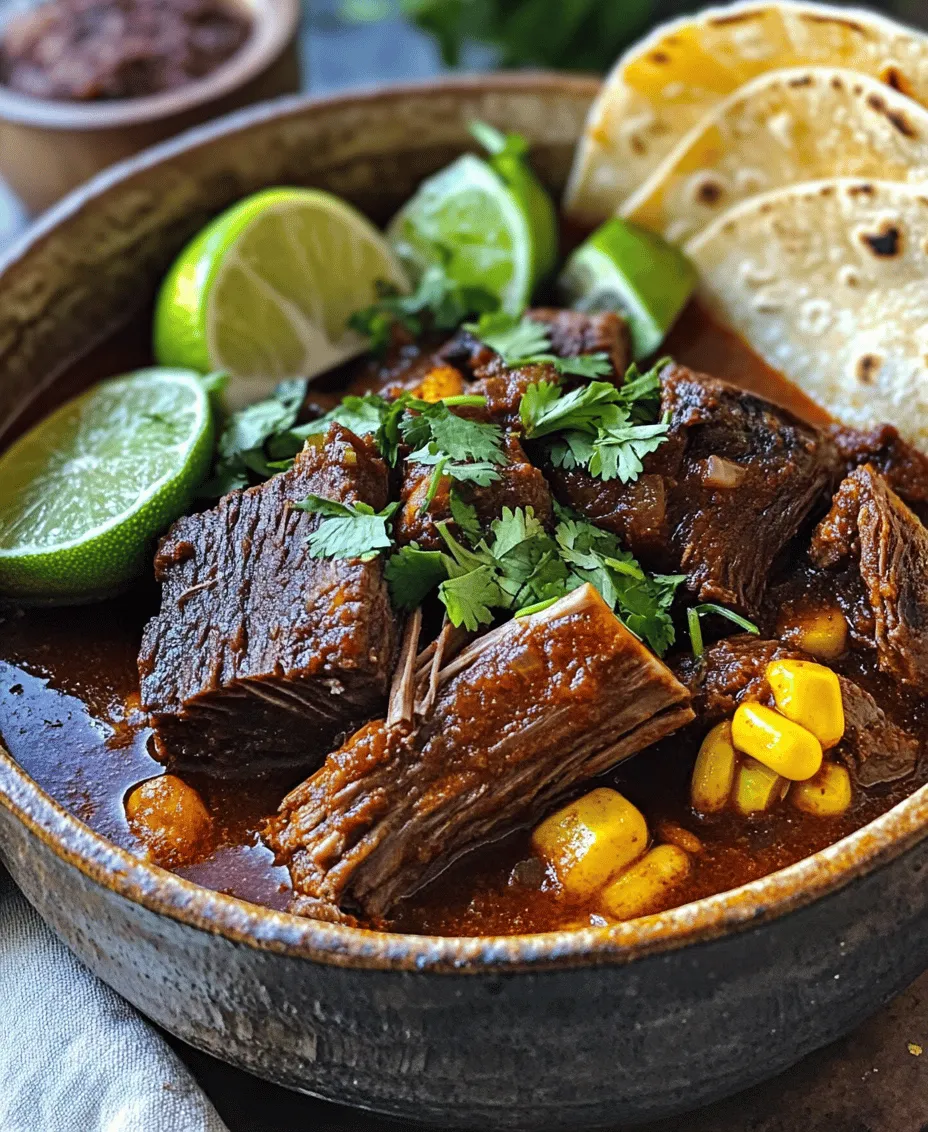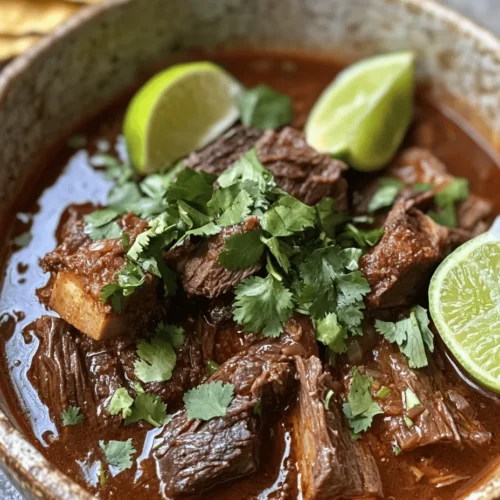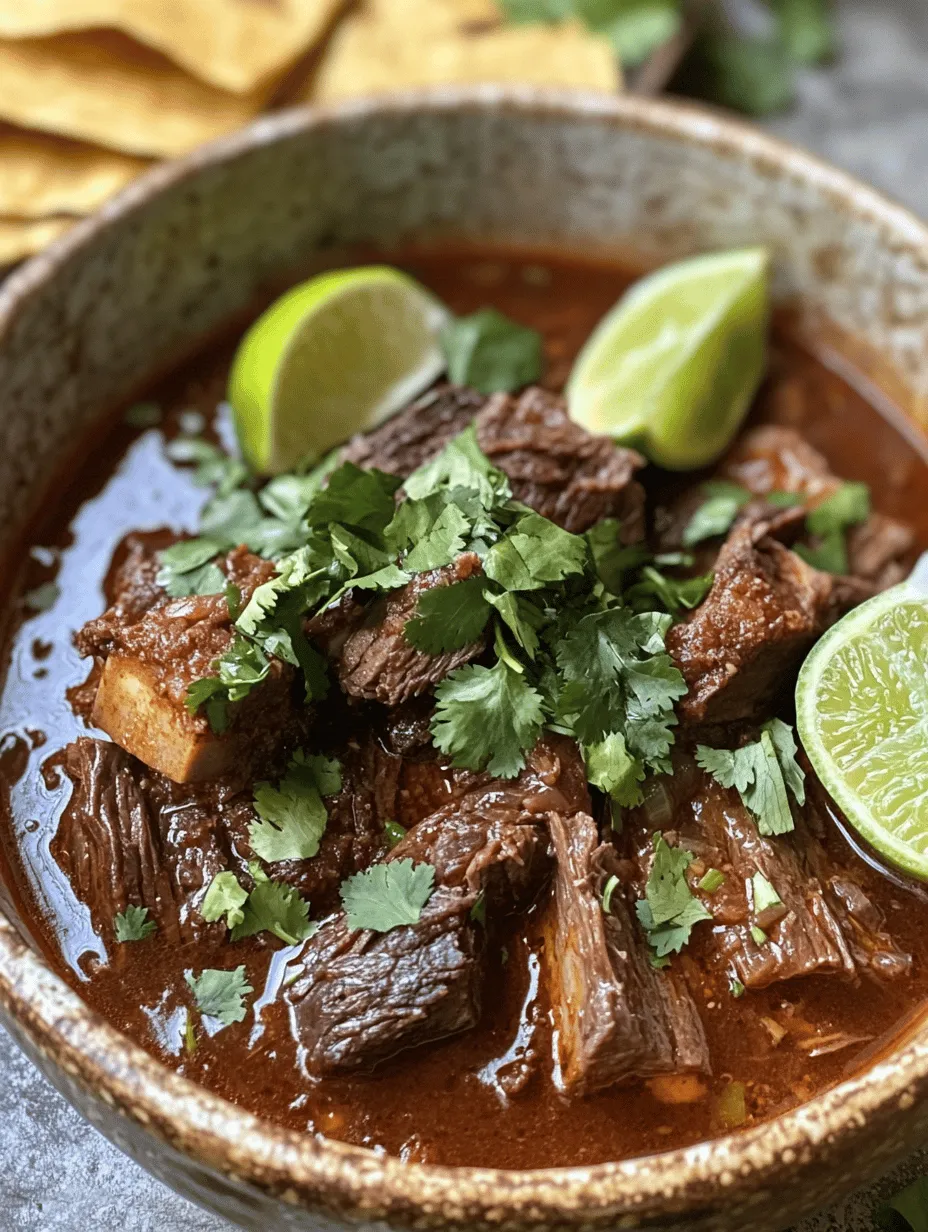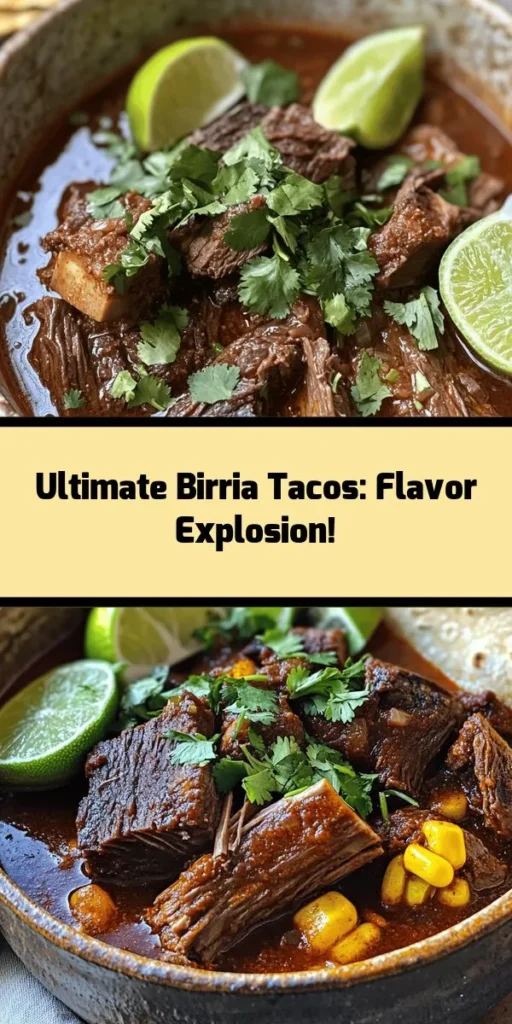Introduction
Birria is more than just a dish; it’s a celebration of culture, flavor, and tradition that has transcended borders to become a beloved staple in Mexican cuisine. Originating from the western state of Jalisco, Birria is a savory stew traditionally made from goat meat, though you’ll find countless variations featuring beef, lamb, and even chicken. This dish holds a special place in Mexican heritage, often served during festive occasions and family gatherings, symbolizing warmth, togetherness, and culinary artistry.
What makes Birria so enticing is its complex flavor profile—a harmonious blend of spices, tender meat, and rich broth that tantalizes the taste buds. The slow cooking process allows the meat to absorb the aromatic flavors from a medley of spices and chilies, resulting in a dish that is both comforting and satisfying. Traditionally served as a soup or as filling for tacos, Birria can be enjoyed in various ways, making it a versatile dish suitable for any meal or occasion.
In recent years, Birria has gained immense popularity beyond its Jalisco roots, becoming a food trend that’s captured the hearts of food enthusiasts worldwide. Whether you’re indulging in a steaming bowl of Birria broth or savoring tacos filled with succulent meat and garnished with fresh herbs, this dish promises a delightful culinary experience that you’ll want to share with family and friends. Join me as we dive into the world of Birria, exploring its rich history, essential ingredients, and step-by-step instructions to create your own Birria bliss.
Understanding Birria
A Rich History and Regional Variations
The origins of Birria can be traced back to the early 19th century in the state of Jalisco, where locals crafted the dish from goat meat, often seasoned with local spices. The name “Birria” is believed to derive from the Spanish word “birria,” which means “worthless” or “poor quality,” signifying the humble beginnings of the dish. However, over the years, Birria has evolved significantly, becoming a culinary masterpiece celebrated across Mexico and beyond.
Birria has various regional interpretations, each boasting unique ingredients and cooking techniques. In Jalisco, the traditional version is often served with a rich, spicy broth for dipping tacos. In contrast, in Tijuana, you might find a more modern twist where the meat is crispy and served in a taco format, accompanied by a side of broth. Regardless of the variation, the heart of Birria remains the same—a slow-cooked, flavorful stew that captures the essence of Mexican cooking.
Essential Ingredients
At the core of Birria are the ingredients that define its distinctive flavor. The choice of meat is crucial, and while traditional recipes call for goat, beef has become a popular alternative, particularly in regions where goat is less accessible. The use of different types of dried chilies is another hallmark of Birria, contributing to its rich color and depth of flavor.
The Role of Dried Chiles
Dried chiles are the backbone of Birria’s flavor profile. The most commonly used chilies include guajillo, ancho, and pasilla peppers:
– Guajillo Peppers: Known for their mild to medium heat, guajillo peppers add a deep, berry-like flavor that enhances the overall taste of the dish. They contribute a vibrant red color to the sauce, making the final dish visually appealing.
– Ancho Peppers: These are dried poblano peppers and are characterized by their sweet, fruity flavor with mild heat. Ancho peppers add a rich, smoky undertone to the Birria, balancing the spiciness of the guajillo.
– Pasilla Peppers: Slightly spicier than guajillo, pasilla peppers provide an earthy flavor and hint of chocolate, adding complexity to the dish.
The Art of Slow-Cooking
One of the defining features of Birria is its slow-cooking method, which allows the flavors to meld beautifully while ensuring that the meat becomes tender and succulent. The process typically involves simmering the meat in a mixture of spices, herbs, and broth for several hours, resulting in a dish that is packed with flavor and has a melt-in-your-mouth texture.
This slow-cooking technique not only enhances the flavors but also breaks down the connective tissues in tougher cuts of meat, making them more palatable. The result is a rich, hearty stew that can be enjoyed on its own or as a filling for tacos.
Ingredients Breakdown
Creating an authentic Birria requires careful selection of ingredients. Each plays a pivotal role in crafting the dish’s signature taste and texture. Below, we explore the key components that will bring your Birria to life:
Beef Chuck Roast
The foundation of our Birria is the beef chuck roast, a cut favored for its rich flavor and ideal fat content. Chuck roast is a well-marbled meat, which means it has a good amount of intramuscular fat that melts during cooking, resulting in moist, tender meat. This cut is particularly well-suited for slow cooking, as it becomes fork-tender and absorbs the spices and flavors from the broth beautifully.
Beef Short Ribs
Adding beef short ribs to the mix takes the flavor profile of your Birria to the next level. These ribs are known for their tenderness and rich, beefy taste, thanks to the marbling of fat that enhances moisture and flavor. The combination of chuck roast and short ribs provides a delightful contrast in textures, ensuring a satisfying eating experience in every bite.
Dried Chiles
As mentioned previously, the choice of dried chiles is critical to achieving the complex flavors that characterize Birria. When selecting your dried chiles, look for plump, slightly oily peppers, as they indicate freshness. Here’s a closer look at the chiles you will use:
– Guajillo Peppers: About 5-6 pieces, stems and seeds removed.
– Ancho Peppers: About 2-3 pieces, stems and seeds removed.
– Pasilla Peppers: About 2 pieces, stems and seeds removed.
Aromatics
Onions and garlic are essential to building the base flavors of Birria. The sweetness of the onions, when sautéed, adds depth to the dish, while garlic imparts a fragrant aroma that enhances the overall experience. Use one large onion, chopped, and about 4-5 cloves of garlic, minced, for a robust flavor foundation.
Spices
A combination of spices will elevate your Birria, creating a symphony of flavors. These typically include:
– Cumin: Adds an earthy, warm flavor.
– Dried Oregano: Offers a hint of herbal brightness.
– Black Pepper: Provides a touch of heat and complexity.
– Cinnamon: A secret ingredient that adds a subtle sweetness and warmth.
– Salt: Essential for bringing out the flavors of the other ingredients.
Broth and Vinegar
Using a quality broth is crucial for achieving a rich and flavorful Birria. Beef broth or stock works best, as it complements the meat and enhances the overall taste. Additionally, a splash of vinegar—typically apple cider vinegar—adds a tangy brightness that balances the richness of the meat and spices.
Garnishes
Finally, garnishes like freshly chopped cilantro and lime wedges are essential for finishing touches. The bright, herbaceous notes of cilantro add freshness, while lime juice offers a zesty contrast, elevating the dish and enhancing its overall flavor profile.
Step-by-Step Cooking Instructions
Now that we’ve covered the essential ingredients, it’s time to dive into the cooking process. Creating Birria is an enjoyable and fulfilling experience, particularly when you see the transformation of simple ingredients into a mouthwatering dish. Here’s how to get started:
Preparing the Chiles
1. Remove Stems and Seeds: Start by carefully removing the stems and seeds from the dried chiles. This step is crucial as the seeds can impart bitterness to the dish. Use kitchen scissors or your hands, and be cautious since some chiles may have a bit of heat.
2. Toast the Chiles: In a dry skillet over medium heat, toast the chiles for about 1-2 minutes on each side. This process enhances their flavor and aroma. Keep an eye on them; the right level of toasting is when they become fragrant but do not burn.
3. Soak the Chiles: After toasting, transfer the chiles to a bowl and cover them with hot water. Let them soak for about 15-20 minutes until they are softened and pliable. This soaking will make it easier to blend them into a smooth sauce.
Blending the Sauce
1. Blend with Broth: Once the chiles are softened, add them to a blender along with half of the beef broth (about 2 cups) and the sautéed onions and garlic. This will create a rich, flavorful sauce.
2. Achieve the Right Consistency: Blend until you reach a smooth consistency, adding more broth as needed to ensure the sauce is pourable but not too thin. Taste the sauce and adjust seasoning with salt or other spices as necessary.
3. Strain the Sauce (Optional): For an ultra-smooth sauce, you can strain the blended mixture through a fine-mesh sieve, but this step is optional depending on your preference for texture.
With the chiles prepared and the sauce blended, you’re on the way to creating a delicious Birria that will impress your family and friends. Stay tuned for the next steps that will guide you through the full cooking process, ensuring every component of your dish melds perfectly together for a truly flavorful feast.

Browning the Meat
To create a truly delicious Birria, the first crucial step is browning the meat. This process not only adds depth of flavor but also enhances the overall color and richness of the dish. Start by choosing a suitable cut of meat—chuck roast, short ribs, or a combination are excellent choices. The marbling in these cuts allows for a tender and flavorful result after simmering.
Techniques for Achieving a Good Sear
Begin by cutting the meat into large cubes, about 2-3 inches in size. This size is ideal for browning and helps maintain the meat’s juiciness during the cooking process. Before searing, season the meat generously with salt and pepper. Heat a large, heavy-bottomed pot or Dutch oven over medium-high heat and add a splash of vegetable oil.
To achieve a good sear, it’s essential to let the oil heat until it shimmers. Once hot, add the meat in batches, ensuring not to overcrowd the pot. Overcrowding can cause the meat to steam rather than sear, resulting in a lackluster flavor. Brown each piece on all sides, which should take about 4-5 minutes per side. Remove the browned meat and set aside, allowing it to rest while you clean the pot for the next step.
Importance of Working in Batches
Working in batches is vital for achieving that rich, caramelized crust on the meat. If you add too much meat at once, the temperature of the pot will drop, and the meat will release moisture, leading to a steaming effect instead of searing. This step is fundamental in building the complex flavors that define a great Birria.
Combining Ingredients
Once you have browned the meat, the next step is to combine it with the sauce and other ingredients. This is where the magic of layering flavors comes into play.
How to Properly Layer Flavors
In the same pot you used for browning the meat, add chopped onions, garlic, and any other aromatics you desire, such as bay leaves or thyme. Sauté these ingredients until they become fragrant and translucent. This process will help develop a robust base for your Birria.
Next, introduce your previously prepared sauce—usually a blend of dried chilies, tomatoes, and spices blended until smooth. Pour the sauce into the pot and stir it together with the sautéed aromatics. Add the browned meat back into the pot and gently mix everything together, ensuring that the meat is well-coated with the sauce.
Adjusting Salt and Liquid Levels
At this stage, taste the mixture and adjust the salt and liquid levels as needed. The amount of liquid will depend on how much sauce you prefer. If you like your Birria soupy, add more broth or water. For a thicker consistency, keep it as is. The key is to trust your palate and make adjustments that suit your taste.
Cooking It Down
Now that your meat is combined with the flavorful sauce, it’s time to cook it down to achieve optimal tenderness.
Simmering Versus Boiling
Bring the mixture to a gentle boil, then reduce the heat to a low simmer. Simmering is crucial as it allows the flavors to meld together while keeping the meat tender. Boiling, on the other hand, can make the meat tough and chewy. Allow the mixture to simmer for about 2-3 hours, or until the meat is fork-tender.
Signs to Look for When the Meat is Done
You will know the meat is done when it easily shreds apart with a fork. The liquid should be rich and flavorful, and the aroma wafting from the pot should entice everyone in the kitchen. If you find that the meat isn’t shredding easily, give it more time to simmer.
Shredding the Meat
Once your meat is tender, it’s time to shred it and mix it back into the broth.
Best Practices for Shredding
Remove the meat from the pot and place it on a large cutting board. Using two forks or your hands (be cautious of heat!), shred the meat into bite-sized pieces. The texture of the shredded meat should be tender yet substantial, allowing it to hold its shape when served.
Importance of Texture
The texture of the meat is critical in Birria, as it must complement the rich, flavorful broth. Mixing the shredded meat back into the broth not only enhances the flavor but also ensures that every bite is a mouthful of flavor. Allow the shredded meat to simmer in the broth for an additional 10-15 minutes to absorb the flavors.
Serving Suggestions
Now that your Birria is ready, let’s discuss some serving suggestions to make your meal visually appealing and delicious.
Presentation Ideas
When serving Birria, presentation is key. Ladle the meat and broth into a bowl, ensuring to include a generous amount of the rich sauce. For a colorful touch, garnish with finely chopped onions, fresh cilantro, and a squeeze of lime. You can also serve it with corn tortillas on the side.
Suggestions for Complementary Sides
Birria pairs beautifully with various sides. Consider serving it alongside Mexican rice, refried beans, or a fresh salad with avocado and tomatoes. These sides not only complement the flavors of Birria but also create a well-rounded meal.
Culinary Variations and Serving Suggestions
Birria can be enjoyed in multiple ways, making it a versatile dish suitable for any occasion.
Creative Ways to Serve Birria
One of the most popular ways to serve Birria is as a taco filling. Simply take warm corn tortillas, fill them with the shredded meat, and top with onions, cilantro, and a drizzle of broth for dipping. Alternatively, you can serve it as a soup, perfect for chilly nights, or even as a dip with tortilla chips for a party appetizer.
Regional Variations in Mexico
In Mexico, Birria varies by region. For instance, in Jalisco, it is often made with goat meat and served with a side of its rich broth. In contrast, the Tijuana version uses beef and is often enjoyed as a taco. Each variation offers a unique twist on this classic dish, reflecting the diverse culinary traditions of Mexico.
Beverage Pairings
To elevate your dining experience, consider pairing your Birria with traditional Mexican beverages. A refreshing glass of aguas frescas, such as horchata or agua de jamaica, complements the rich flavors of the Birria. For those who prefer alcoholic beverages, a crisp Mexican beer or a light red wine can also enhance your meal.
Nutritional Information
Understanding the nutritional profile of Birria can help you appreciate its benefits.
Overview of Nutritional Profile
A standard serving of Birria contains a healthy dose of protein, thanks to the beef or goat meat. Depending on your ingredients, it can also offer essential vitamins and minerals from the herbs and spices used in the broth. Typically, a serving of Birria may contain around 300-400 calories, with a substantial amount of protein and minimal carbohydrates if you opt for a smaller serving of tortillas.
Benefits of the Ingredients Used
The ingredients in Birria are not only flavorful but also nutritious. The meat provides high-quality protein, while the spices—like cumin and oregano—are known for their anti-inflammatory properties. Additionally, the herbs and vegetables used add vitamins, making Birria not only a feast for the senses but also a nourishing dish.
Conclusion
Birria is a dish that encapsulates the essence of traditional Mexican cuisine, rich in flavors and steeped in culture. The techniques of browning the meat, layering flavors, and slow cooking create a complex and satisfying dish that is perfect for sharing with family and friends.
The communal aspect of enjoying Birria, whether served as tacos, a hearty soup, or a flavorful dip, brings people together around the table. We encourage you to try this recipe at home and experience the joy of cooking and savoring a beloved dish that has stood the test of time. Whether you’re celebrating a special occasion or simply enjoying a family meal, Birria is sure to impress and delight all who partake.



